“Holy $#*&!” Tinted visor hides look of shock, terror on Mark Hoyer’s face as he experiences his first hookin’-n-bookin’ near-2g launch on the Harley-Davidson V-Rod-based production dragbike.
From the March 2006 issue of Cycle World.
It is like walking on tiptoes to the brink of Armageddon. It’s louder than hell, you’re not sure what’s in your near future, you’re wondering about your past, and nothing happens until everything happens and you are hurled into the abyss at nearly 2g’s.
Welcome to the intense world of creeping the Harley-Davidson VRXSC Screamin' Eagle V-Rod Destroyer into the staging lights in front of a Pro tree at California Speedway's NHRA-sanctioned quarter-mile dragstrip in Fontana.
Two low-speed practice runs and all the excellent coaching from Harley Fleet Center chief and pro dragger “Super” Gene Thomason (runs 6.70s at 205mph on a Top Fuel Harley and is 2000 AHDRA Western Division Super Gas champ) cannot prepare you for the stunning violence unleashed when you throw the lever on the MTC multi-stage lockup clutch with that 165-horse V-Rod Twin cracking like nuclear thunder under your chest.
It was both shocking and elating. Despite the overwhelming storm of motion and events, I somehow managed to remember to thumb the shift button when the bright-red LED shift lights flashed before my eyes just after my life did, kept my wrist from rolling off the throttle and rode the lightning to the fastest quarter-mile of my motorcycling career, a 9.971 at 134 mph–on my first pass! Of course, I had no idea about the results, and as I rolled back into the pits wide-eyed and shocked by one of the most awesome experiences of my life, Thomason was grinning when he said “Good job” and told me my time. Then Harley Communication Manager Paul James walked up, handed me my time slip and said, “Congratulations, you’re banned!”
What?
Wheelie bar and sidepanels are included, giving you extra acreage for sponsor stickers when you turn Pro. DRZ 530 chain (same as Vance & Hines Top Fueler’s) replaces stocker’s belt final drive. Both countershaft and rear sprockets are quick-change to aid ratio alteration. MTC multi-stage-lockup clutch means you just pin the throttle and throw the clutch on launch.
“Nobody told us this,” James continued, “but anybody who runs under 10 seconds at a sanctioned track has to have an NHRA Pro license. You’re the first journalist we’ve had here to do that, and the track won’t let you run again. You’re done for the day.”
I could not allow this to happen, so I ran back to my car and changed leathers and helmet to disguise myself so that I might sneak in another run. James, meanwhile, talked to the track staff who told him that if we filled out the application and got a doctor out there to give physicals to everybody who ran under 10 seconds, we could get our NHRA tickets and run again.
Dr. David Asher (a 2003 Fat Boy owner) was called by an MSF instructor at the launch who happened to have had him in a recent class. The good Dr. Asher cancelled his afternoon appointments and drove out to the track. So I peed in a cup, he took my pulse and asked me if I was crazy. I said no, he signed the sheet and I am now Mark Hoyer, NHRA Licensed Professional Drag Racer. That is sweet indeed.
Better yet, I kept flogging the Destroyer, and on my sixth and final run, I clocked a 9.783 at 133.88 mph, with a .474 reaction time. The latter number is relatively glacial compared to pros who regularly do .420s and quicker (a .400 is perfect), but there was great satisfaction in having Thomason look at my time slip and say it was a good solid run. For his part, Thomason has turned in a 9.2-second Destroyer pass, with the promise of faster times still.
There is one instrument and no ignition key. LED programmable shift light has digital tachometer. To fire up, flip the kill switch to “run” and hit the starter button. Left turnsignal button is wired to Pingel electric-over-air shifter. “Dead-man” tether clips to leathers and kills the engine in the case of rider/bike separation.
Was it difficult? There is a certain organization of action, a necessity for precision and clarity of mind that allow a rider to go to that edge and react perfectly when the lights flash. I hope to get there someday… I have a new respect for the consistency of top racers. But the rpm-adjustable stutter-box launch controller, wheelie bar and 7-inch-wide Screamin’ Eagle Dunlop slick (good for 20 to 30 runs, and available at an H-D dealer near you for $152) make Destroyer launching as simple as pinning the throttle when you stage, then throwing the clutch at the light. It takes a certain amount of fortitude to keep the throttle wide open during the fraction of a second that you go from complete rest (physically, if not spiritually) to almost 2g’s on this 550-pound machine!
But one of the reasons it was so easy to get into the 9s was that Thomason and his mechanics, Bobby Yarnall and Thomas Richter, made sure the Destroyer was set up to work for the conditions. Their extensive experience meant the bike was dialed in right, so the subtlety of tire pressure (“1 psi makes all the difference in the world”), wheelie-bar height, launch rpm (set at a conservative 7500 revs for us) and clutch tune were all taken care of before I ever stretched out in the Matt Hines-designed riding position. Plus, the Pingel electric-over-air shifter supply bottle was aired up to 140 psi after every run, to ensure that the actuator had the authoritative snap to make clean, push-button shifts in the Andrews Products racing-prepped five-speed box. So, really, it was Thomason’s experience that allowed me the freedom to roll up to the line and “throw ’n’ go” on my own terms.
Of course, more important than even the track-day tuning was the construction of the bike itself. The Destroyer was simply a twinkle in Custom Vehicle Operations’ eye in October, 2004, but by Harley’s dealer show less than a year later, they had an essentially finished production dragbike for sale at $31,249. Initial build was to be 150-300 units, but dealer reaction was overwhelming, and more than 600 orders were placed. H-D is now saying “limited run” when queried about production numbers, implying that it is happy to keep building as long as there are checks being written. And why not? Let’s see, 600 times $31K… not a bad wad!
Seat height is 25.5 inches. There are no rear shocks, only struts.
“This bike is my baby,” said Destroyer Project Lead Joe Nutt. “That we were able to get it done so fast is a testament to the dedication of our CVO team and our suppliers. Plus, I’ve learned over the years that when a supplier says, ‘We can’t,’ I have to look them in the eye and say, ‘That’s not good enough. What’s it going to take to get this part done?’”
Joe’s a nice, friendly guy, but when he stared me down over dinner to show me how he did it, I was about ready to start making any prototype part he wanted. ASAP!
That the Destroyer even exists is due to the passion of the people in CVO and to the freedom they are given. The small division’s hand-built machines don’t have the normal constraints of price and “produceability” that standard assembly-line models have, and so when somebody says, “We need to connect the dots between the standard V-Rod, the Screamin’ Eagle V-Rod and the championship-winning Vance & Hines V-Rod NHRA Top Fueler,” CVO steps up to the plate with this production race-ready Destroyer. And quickly are the dots connected (except for one DOT, which is to say this bike is not street-legal). Production racers of any kind are rare, dragbikes even more so. And a production dragbike from The Motor Company? That is off the hook!
Wheelie-bar height is tunable to control weight transfer on launch for best hook-up. While there is a taillight, there is no other “street” equipment–the Destroyer is not DOT-legal. Bet somebody shows up at Daytona on one with a plate, though!
There is, however, a surprising degree of “stockness” to the Destroyer. The frame upper is standard V-Rod A-model, while the lower is from the recently introduced Street Rod (no forward foot-control lugs). The swingarm is the same thick-wall casting as used on the big-bore street-going Screamin’ Eagle V-Rod, with slightly different machining to fit the 18 x 6-inch RC Engineering wheel and meaty 7-inch wide, 25-inch-tall slick tire. Wheelbase of 66.9 inches is the same as the Night Rod’s, shorter than a stock V-Rod’s. Fork lowers are stock, with shortened tubes. Steering-head angle is 34 degrees, and the wide triple-clamps keep that angle, rather than adding 4 degrees of fork rake as on the V-Rod. Trail is shortened to 3.5 inches from 3.9, and the fork is fitted with a friction steering damper.
As mentioned above, two-time NHRA Top Fuel champ Matt Hines fine-tuned the riding position, and the special risers and drag bar are basically at shoulder level when you are stretched out in the seat. My only complaint is that the footpegs way out behind you are a little high. My previous experience aboard a dragbike showed me that it’s nice if you can have your feet on the pegs as you creep the bike forward to stage with your toes, then your boots are already on the pegs when you launch.
Hoyer swears he’s not that big. Lowered Destroyer looks tiny from the front. “Christmas tree” starting lights control your world at the line.
Thankfully, Matt made sure there was a big lump to hold your ass in the seat, because this engine pounds out major horses. The cases are stock V-Rod with extra machining, but the crank is a special piece that adds 3mm to the stroke. Bore is the Screamin’ Eagle 105mm. Initially, the team tried 108mm but found in the machining process that the cases couldn’t readily accept such a large hole (meaning they ended up with air where there should have been aluminum). So the 105 x 75mm, liquid-cooled, 60-degree V-Twin displaces 1300cc and is said to produce more than 165 horsepower and 97 foot-pounds of torque, running on VP Ultimate 4 fuel, the leaded, oxygenated 92-octane gas found to give best power. Pump gas with octane boost was also tested and found to be acceptable. Special head castings use smaller port cores so that when they are CNC machined into great inhaling wind tunnels to feed the forged pistons, there is enough material there to make the whole port machine-smooth.
“It takes extra machining time in production,” says Nutt, “but the bigger port cores in the stock mold left rough casting that inhibited flow. We needed the extra material to make them really nice all the way through.”
The four-valve heads have 42mm intakes and 34.5mm exhausts, plus 2 and .9mm respectively, with beehive-shaped valve springs to keep those high-lift harmonics from inhibiting valve control. The net result of the headwork are units that flow 400 cfm apiece, sucking in through very large 58mm-diameter fuel-injection throttle bodies. There is no air filter, just velocity stacks, while a “lift kit” for the airbox cover (what looks like the fuel tank) is included to make sure plenty of flow is available. Add to this radical cams (278 degrees of intake duration, 14.35mm lift and 199 degrees of overlap) and you have an engine that really, really wants to run at high rpm. The sizzling crack from the tuned, stepped header and 3.125-inch outlet comes partly as a result of the super-high 14.0:1 compression, partly just because the unbaffled pipes are shorter than your arms and bigger than a sewage main. And yet, this engine idles well enough (at 2000 rpm) and starts on the standard electric starter. For the latter ability, thank the long intake/exhaust valve overlap that effectively lowers compression at cranking speed.
Turn your head and cough: Dr. David Asher rushed out to the track and delivered physicals to the 9 Second Club so they could get their NHRA licenses, mandatory for sub-10-second runs at sanctioned facilities.
So, what we have here is a ready-to-run, electric-start dragbike with the mother of all owner's manuals (suppliers list, tuning tips, parts book, very complete specs, torque figures for apparently all threaded pieces, and more), available Race Pack data-acquisition system (about $3000 plus your own laptop computer) and tires available from your local dealer. There is an included Clutch Tuner Kit from MTC that allows you to vary lock-up performance to match conditions, as well as an EFI race tuner for optimal fueling. Like the Yamaha TZs of yore, it is a production racer, very well dialed-in for its intended use at a reasonable cost of entry.
Where to race? How about the Pro-level spec series in the All Harley Drag Racing Association for 2006? There also are suitable classes in AMA Prostar and NHRA. Perhaps the best part of all is that the Destroyer stood up to two days of hammering at California Dragway with only a rear tire change and chain adjustment, while never missing a beat. It was hardly even given time to cool between mid-to-high-9-second runs! Durability testing during development included 160 runs on one Destroyer, essentially a full season of AHDRA racing.
“We want to build products that fulfill our customers’ dreams on the street or on the dragstrip,” said Jim Hoffman, CVO Director. “The CVO goal is to build aspirational halo projects. They’re not for everyone, but are there to show what’s possible.”
Me, I never dreamed I’d get my Pro license. And I really never dreamed I’d have to pee in a cup in a Port-A-John to get it.










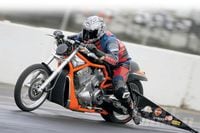

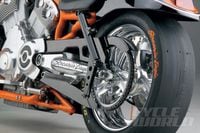

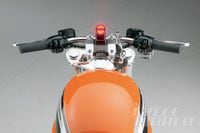
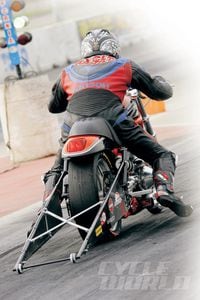
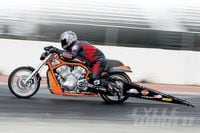
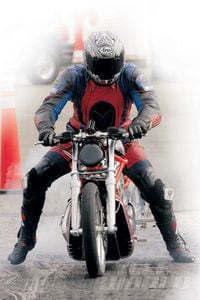
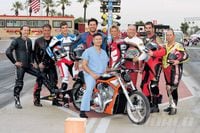
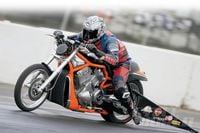


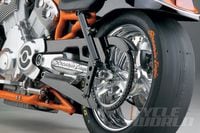
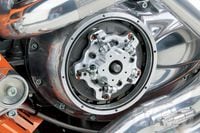
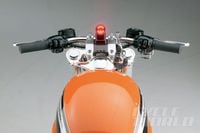

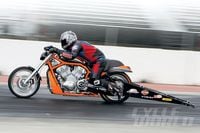
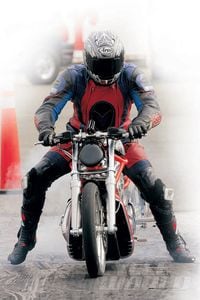

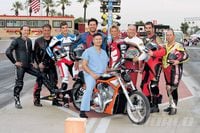

/cloudfront-us-east-1.images.arcpublishing.com/octane/P3DLTISFGJA43L5QXVH7365UNY.jpg)
/cloudfront-us-east-1.images.arcpublishing.com/octane/H6FFG4YQMREO3DTADIJMECNS7Y.jpg)
/cloudfront-us-east-1.images.arcpublishing.com/octane/QCUUDRRAIFHDDGB5OTZVKUS554.jpg)
/cloudfront-us-east-1.images.arcpublishing.com/octane/RBDRR2OHFFBPRNXW6V3FN2SNAM.jpg)
/cloudfront-us-east-1.images.arcpublishing.com/octane/EFFSPCZVBBCMTNGVEQMB7NNKIU.jpg)
/cloudfront-us-east-1.images.arcpublishing.com/octane/5GP3PUGFKVGUVCEYG4ZBDYLNBE.jpg)
/cloudfront-us-east-1.images.arcpublishing.com/octane/USTSFGXT3ZGL7BT7B66WMSSKTI.jpg)
/cloudfront-us-east-1.images.arcpublishing.com/octane/Z7YU6FSR6NEKVMKT5CZPMKIVLE.jpg)
/cloudfront-us-east-1.images.arcpublishing.com/octane/MOP35BTV3FFANFBUJKU2RJRTZ4.jpg)
/cloudfront-us-east-1.images.arcpublishing.com/octane/UWTN4NTIJFD25MPXBOVS4DFOXE.jpg)
/cloudfront-us-east-1.images.arcpublishing.com/octane/SIFOY54XMFGEHAUYNFUYVW7IZ4.jpg)
/cloudfront-us-east-1.images.arcpublishing.com/octane/HMC5X3JZHRASXGVCVNBJBWWGSI.jpg)
/cloudfront-us-east-1.images.arcpublishing.com/octane/UIWGXRZDM5HZXJOWXET2DZIWJE.jpg)
/cloudfront-us-east-1.images.arcpublishing.com/octane/QSS5DZ6SKJEU3AKE4KDAWYBEFY.jpg)
/cloudfront-us-east-1.images.arcpublishing.com/octane/SMCEQCLWRVEFTJJES6TAHB3OOQ.jpg)
/cloudfront-us-east-1.images.arcpublishing.com/octane/JCACIDCAC5FUNPTXO2BOUHGGII.jpg)
/cloudfront-us-east-1.images.arcpublishing.com/octane/DC7ZGILA2BCJXHZIUNYGV7JSEA.jpg)
/cloudfront-us-east-1.images.arcpublishing.com/octane/EWJEZUGWEZGABDEQWB64WL46GQ.jpg)
/cloudfront-us-east-1.images.arcpublishing.com/octane/5NHBMRMSFVD5JAPFNMBMNPGXQE.jpg)
/cloudfront-us-east-1.images.arcpublishing.com/octane/WHE43SCPLJBRNANAJAGXHOAIEU.jpg)
/cloudfront-us-east-1.images.arcpublishing.com/octane/6R56AQAW6NDE7BBIJ3SMCOOY5A.jpg)
/cloudfront-us-east-1.images.arcpublishing.com/octane/JMQTUE2FKZFURJTJXDMM4V47AQ.jpg)
/cloudfront-us-east-1.images.arcpublishing.com/octane/P2QYJDMQNVEANMQFXHNB3OVFKQ.jpg)
/cloudfront-us-east-1.images.arcpublishing.com/octane/VNKGXM4AA5BPRGERJOPV6GADAQ.jpg)